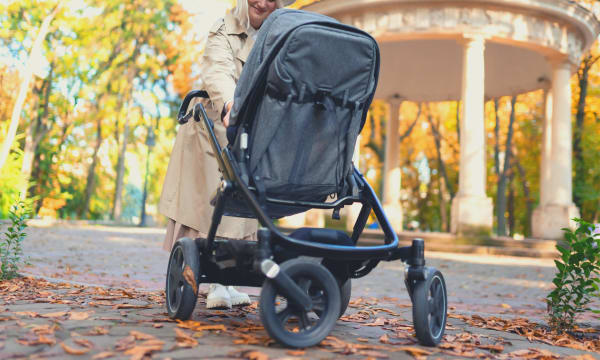Swivel-wheels stroller chassis: Why (almost always) yes? When are fixed wheels better?

TL;DR: Most lifestyles will benefit from a stroller frame with swivel wheels. With almost all strollers, such wheels CAN be locked to tackle rougher terrain if necessary (and the rest of the time, locked wheels would only be a burden). A model with fixed wheels has its place, of course - firstly, for sports use, and then, for challenging terrain (e.g., village) conditions and parents rarely ever traveling with their pram.
The first pram I ever looked at (and almost bought) was a beautiful-looking retro-style model in beige color. Yeah, beige is the only thing I remember about it - not the brand, nor model name, just the pretty color, vintage style with lace detail, and the large, retro fixed wheels. I never got to buying it - I was gifted a very different (and a much uglier) used green one to start with and get to know strollers before making (numerous) different choices later. Fast-forward, I tried so many models and worked with strollers, prams, pushchairs, and buggies for years to tell you today: I am glad I didn't buy that fxed-wheels stroller system at that time. It doesn't mean it was bad - I'll never know... but I know now that swivel wheels are a better option in most cases (that is even more true for urban moms like me) - even if there are places for fixed-wheel prams or pushchairs in some lifestyles.
I'll start with the obvious - swivel front wheels are simply much, much more agile. Even a stroller/pram/pushchair with a not-the-best center of gravity can be managed rather well thanks to the swiveling wheels. A fixed-wheel stroller is, of course, a more stable one - but every turn or a change of direction means lifting the front part and turning it lifted. If it doesn't fit you from the point of maneuverability, it can be very uncomfortable.
There are, by all means, prams with a perfectly thought-of chassis, where even I must say kudos to the designer, making it as easy to maneuver while having fixed wheels. I once tried an old Emmaljunga, ending up surprised over the ease of push even if the wheels did not turn... If the center of gravity, however, is not perfectly balanced or doesn't suit your height/body type, it will be a bit of a suffering every time you need to turn.

With the agility and maneuverability of the swivel front wheels goes, hand in hand, more convenient use in narrow shop aisles or any place you need to "turn on the spot". You'll also appreciate the turnability and easier manipulation with more than one child to look after, like with an older little one you need to hold hand with while pushing the baby.
Most of my strollers and stroller systems were swivel-wheel models, and I can also say that 99% of such will offer you the possibility of locking the front wheels. So even if you find that there are rough patches on your everyday strolls, you can lock your wheels and go through that grass, gravel, or stone surface - or, for those few meters, pull your stroller behind on the rear wheels. I very rarely locked the wheels even on grass, though (I found it kind of annoying) - except for maybe strollers with very tiny wheels that could get stuck. Most of the time, even a bit of terrain could be easily tackled with swivel wheels. Of course, everybody sees this differently and uses their gear in their own way - and that is why wheel locks exist and are available on almost every swivel-wheel model. No need to take that modern feature away from yourself if you really don't go on harsh terrain every day, most of the day.
I would like to finish off with those life situations that are really much better with a stroller with non-swivel - fixed front wheel(s).
First is sports use - jogging, in-line skating, absolutely.
Yes, there are strollers good for every day as well as for jogging - meaning they have a large front swivel wheel that can be locked for the purpose of running or in-line skating. However, REMEMBER has to accept such a situation as a compromise - and not a 100% on either side of usability). These jogging strollers are a bit too bulky and long for casual use, usually (doable, of course, if that is what you are OK with). For jogging, they are a bit more wobbly and sensitive in the joint since it is not as tight as it can get - meaning they can get damaged or at least loosen over time with regular sports use (it's more meant for occasional running, the swivel-wheel models).
Running with a stroller with a fixed front wheel is overall much better, comfort-of-use- and longevity-wise... But, on the other hand, usual chores and urban strolling are, of course, less comfy with a larger model with a fixed front wheel.
And yes, I say front wheel (not wheels) because, for jogging, a dedicated three-wheeler is the only optimal choice if you take the child's safety into account. It is so because of the stroller's stability as well as quality adapted for such an activity.
The second real use for the fixed wheels would be parents living in a village or near/in a forest, with very rough terrain conditions around - and the need for traveling with that particular stroller is minimal. (This could be because of another - compact model kept in the car for such purpose). A parent not thinking about compactness - but prioritizing the stability and usability on rough terrain - will be happy about the wheels not getting stuck on every root or in any hole. Quick turning will be harder, but getting the stroller over obstacles that much easier.
I know that those pretty vintage-style prams look incredible on a modern street. They are, however, very very bulky to fold in a car boot, and they are often rather large for petite mums to see over them. The best there is often the look and the space in the carrycot (if there's a seat unit, it is often much worse, practical use-wise). So if you're not planning on several different stroller models to buy and use, you might think more about the usefulness of such a stroller before buying it (as opposed to the cool look of it). Unless the retro pram would be primarily for showing off around the street - which is, of course, a valid choice if you have the money and space for that... or you expect your baby in a snowy season and want to keep your little one as long as possible in the (beautiful) bassinet.
